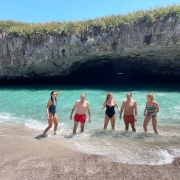Hiking in the Nayarit Jungle amongst Naranjilla, Cacao and Flor de Jamaica

You never know what you’ll discover when hiking through the jungles of Riviera Nayarit, Mexico. On this particular day, my husband David and I decided to explore the towns of El Monteón and Punta Raza.
About midway along our hike, we stumbled upon this very unusual and prickly plant. It was the bright orange fruit that caught our attention. After spending a few hours trying to identify it online, I learned that the Naranjilla plant is a member of the nightshade family and is much admired as an ornamental foliage plant. The small orange fruit is about the size of a golf ball and is covered in white hair. The flesh and seeds are edible and it is said to taste like a cross between a pineapple and lemon, and the juice is used in ice cream, sauces, jams and desserts.
Upon closer inspection, we noticed that the entire plant was covered with prickly spines – even the leaves have spines on both sides. The flowers were spent, but they obviously had 5 petals when in bloom.
I have never actually seen a Cacao Tree (Theobroma cacao) up close and personal until today. Oddly enough, we only spotted one lonely tree in the entire forest. The cacao tree (pronounced kah-KOW) is an evergreen that grows to about 15-25 feet. Trees are typically found growing in the shade of the rainforest in climates with high humidity and rainfall. The fruit and flowers of the cacao tree grow directly from its trunk. The fruit, called a pod (shown below), is oblong in shape and 5-12 inches in length. When the pod is young it is green in color, and can turn yellow, red or purple when ripe. Each pod contains 20-40 almond-shaped seeds, called cacao beans. Pods are usually harvested at the end of the wet, or rainy, season. They are split open and the beans are scraped out. The raw cacoa beans undergo a lengthy process to prepare them for chocolate making. While Mexico ranks 11th place in the world for cacoa production (grown primarily in the states of Tabasco, Chiapas, Guerrero and Oaxaca), most of the world’s cacao is grown in West Africa, South America and Asia.
Flor de Jamaica (Roselle)
I have only once seen Flor de Jamaica plants growing in the Jaltemba Bay area. The plants (also known as hibiscus or roselle) are grown commercially and the calyces, which are the cup-like structures that form after the petals drop, are dried in the sun, packaged and distributed. Bags of dried Flor de Jamaica can be purchased in nearly every Mexican grocery store and it is commonly steeped in boiling water to make a popular bright red and slightly tart beverage called Agua de Jamaica or Hibiscus tea. It is high in calcium, niacin, riboflavin and iron. Had we gone a week earlier, we may have been able to see more of their beautiful papery blooms.
A few other plants commonly found in the jungles of Nayarit…

Oil Palm

Papaya

Tabachin (you can view their beautiful red blooms and learn more about Tabachin on our blog.)
And last, but certainly not least, the majestic Higuera Blanca (top photo).
Originally published on JaltembaBayLife.com










Leave a Reply
Want to join the discussion?Feel free to contribute!